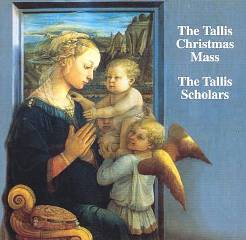Tallis - The Christmas Mass (Missa Puer Natus Est Nobis) [2001]
Tallis - The Christmas Mass (Missa Puer Natus Est Nobis) [2001]

1. Missa Puer Natuus Est Nobis: Gloria 2. Missa Puer Natuus Est Nobis: Sanctus & Benedictus 3. Missa Puer Natuus Est Nobis: Agnus Dei 4. Audivi Vocem 5. Magnificat (Four Voices) 6. Ave, Dei Patris Filia The Tallis Scholars - Choir/Chorus Paul Agnew - Tenor Philip Cave - Voices Stephen Charlesworth -Bass Robert Harre-Jones - Alto Ruth Holton - Treble Robert Johnston - Michael Lees - Alto William Missin - Alto Adrian Peacock - Bass Deborah Roberts - Treble Francis Steele - Bass Caroline Trevor - Alto Julian Walker – Bass
Tallis's Mass Puer natus est nobis, based on the Christmas plainchant of the same name, is the most elaborate setting of the Ordinary to come from England in the middle of the 16th century; it is also by far the most elaborate by Tallis himself. Its scale is determined by the way the plainchant is distributed through the polyphony. This is done in quite exceptionally long notes, always in the tenor, in a style which had been popular in England (and elsewhere) early in the century but of which no example from later than about 1540 is otherwise known. The cantus firmus thus makes the movements lengthy in performance; but Tallis's music is also substantial vertically, requiring an unusual choir of seven voices, scored mean, mean, alto, alto, tenor, bass, bass. Since all these voices are used almost continuously - there are no scorings down to trios and quartets as was customary in earlier festal masses - the cumulative effect really is massive. In our interpretation we have encouraged this in-built sonority to speak for itself by making the phrases as spacious as possible.
There can be no doubt that Tallis wrote this piece for a big occasion. Although there is no conclusive proof, the evidence of the choice of chant, the archaicising in having a long-note cantus firmus against the dramatically more modern (and Flemish) use of imitation between the voices, and the sheer scale, suggests it was composed for the visit of Philip II of Spain to England in 1554, when he married Queen Mary. It is known that Philip was in the country on Christmas Day and it is well known that English Catholics were hoping Mary would give birth to a son and heir (so the words Puer natus est nobis probably had a double relevance). But for Tallis perhaps the most significant aspect of the festivities was that Philip had brought with him his famous Capilla Flamenca, or Flemish Chapel Choir. This would have put Tallis very considerably on his professional mettle, since it contained some of the leading names in Flemish composition, including Philippe de Monte. He chose to impress them by combining old techniques with new in a virtuoso mix; he also preferred a thick, essentially Flemish sonority over the more traditionally spacious English scoring involving the high treble voice, which he did make use of in other music dating from Mary's reign. The strong Flemish references in Puer natus est nobis were surely deliberate.
Despite the discoveries of recent years which have rendered Puer natus est nobis complete enough to perform in three of its movements, the Credo is still almost wholly missing (apart from the final phrase from "Et expecto"). Of the others the Gloria is entire but the Sanctus is lacking its second alto in the opening section. The Agnus Dei is the least complete, missing the second alto throughout and the first bass during the first two invocations. These parts were supplied by David Wulstan and Sally Dunkley. Missing also is a rational explanation for why Tallis broke the Puer natus est nobis plainchant up as he did to form the cantus firmus. As Wulstan and Dunkley observe, its tones are:
"neither given in long notes of equal value, nor in decorated form. Instead they are arranged rhythmically according to a cabalistic pattern, the significance of which is difficult to discern". ---Peter Phillips, gimell.com
download (mp3 @320 kbs):
oboom yandex 4shared mega mediafire zalivalka cloudmailru uplea








